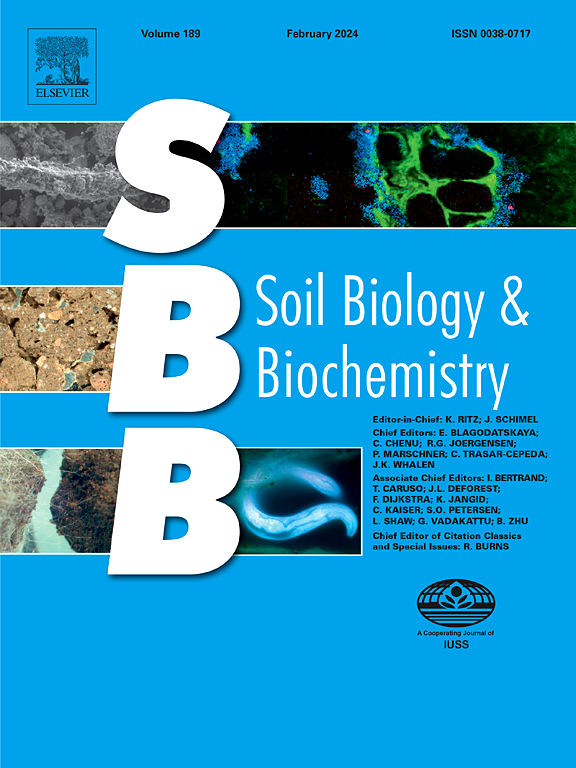Drought impairs detritivore feeding activity more strongly in northern than in southern European latitudes
IF 9.8
1区 农林科学
Q1 SOIL SCIENCE
引用次数: 0
Abstract
Soil detritivores play key roles in decomposition processes closely related to ecosystem services. Drought and soil organic carbon depletion due to agricultural management are detrimental to soil biodiversity, but their interactive effects on soil biota and associated processes have not been thoroughly investigated. In 2018, we used rain-out shelters to experimentally induce drought in wheat fields of contrasting levels of organic carbon in Sweden, Germany and Spain. That year Europe experienced a climatic dipole, with exceptionally severe droughts in northern latitudes. We assessed the feeding activity of soil detritivores by bait-lamina tests, and measured several abiotic and biotic soil parameters. In the peak of the dipole drought (summer) southern fields had the driest soils. Nonetheless, detritivore feeding activity responded to the experimental drought by shifting to deeper soil layers there. Low soil organic carbon (SOC) levels exacerbated the latter effect. However, in this same period, feeding activity in northern and central Europe was two orders of magnitude lower than in the south, and failed to respond to either the experimental treatment and/or SOC levels. Using mixed-effects longitudinal random forests, we detected various candidate drivers of detritivore feeding activity: soil moisture, phosphorus content, bacteria and nematodes. Different bacterial taxa were associated to detritivory in each country, but their potential influence was pervasive. Thus, our results suggest that drought had adverse effects on detritivore feeding, which were exacerbated northwards due to the climatic dipole. Increased SOC levels mitigated drought effects only in southern soils. Regional adaptation of soil biota to aridity could explain the response of detritivores in southern Europe to drought. Machine learning algorithms arise as useful tools for exploring potential drivers relating biodiversity to soil processes. Overall, future research on the effects of drought on soil biodiversity and processes will be key for tackling climate change impacts in terrestrial ecosystems.
北欧纬度地区的干旱对食腐动物觅食活动的影响比南欧纬度地区更大
土壤中的食腐动物在与生态系统服务密切相关的分解过程中发挥着关键作用。农业管理导致的干旱和土壤有机碳耗竭不利于土壤生物多样性,但它们对土壤生物区系和相关过程的交互影响尚未得到深入研究。2018 年,我们利用避雨棚在瑞典、德国和西班牙有机碳含量对比强烈的麦田中实验性地诱发了干旱。这一年,欧洲经历了气候偶极,北纬地区的干旱异常严重。我们通过诱饵-拉米娜试验评估了土壤食腐动物的取食活动,并测量了几个非生物和生物土壤参数。在偶极干旱的高峰期(夏季),南部田地的土壤最为干旱。然而,食肉动物的取食活动对试验性干旱做出了反应,它们转移到了那里更深的土层。土壤有机碳(SOC)含量低加剧了后一种效应。然而,在同一时期,欧洲北部和中部的取食活动比南部低两个数量级,而且对实验处理和/或土壤有机碳水平都没有反应。利用混合效应纵向随机森林,我们检测到了食腐动物取食活动的各种候选驱动因素:土壤湿度、磷含量、细菌和线虫。在每个国家,不同的细菌类群与食肉动物的取食有关,但它们的潜在影响是普遍存在的。因此,我们的研究结果表明,干旱会对食肉动物的取食产生不利影响,而气候偶极子会加剧这种影响。只有在南部土壤中,SOC水平的增加才会减轻干旱的影响。土壤生物区系对干旱的区域适应性可以解释南欧食腐动物对干旱的反应。机器学习算法是探索生物多样性与土壤过程相关潜在驱动因素的有用工具。总之,未来关于干旱对土壤生物多样性和过程影响的研究将是应对陆地生态系统气候变化影响的关键。
本文章由计算机程序翻译,如有差异,请以英文原文为准。
求助全文
约1分钟内获得全文
求助全文
来源期刊

Soil Biology & Biochemistry
农林科学-土壤科学
CiteScore
16.90
自引率
9.30%
发文量
312
审稿时长
49 days
期刊介绍:
Soil Biology & Biochemistry publishes original research articles of international significance focusing on biological processes in soil and their applications to soil and environmental quality. Major topics include the ecology and biochemical processes of soil organisms, their effects on the environment, and interactions with plants. The journal also welcomes state-of-the-art reviews and discussions on contemporary research in soil biology and biochemistry.
 求助内容:
求助内容: 应助结果提醒方式:
应助结果提醒方式:


